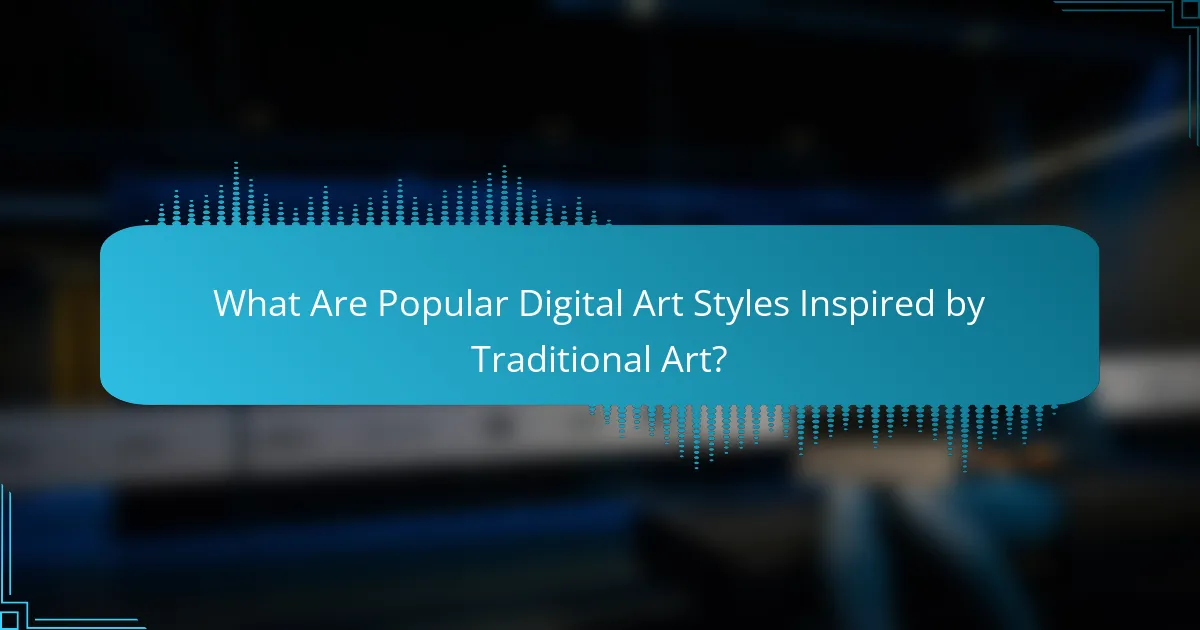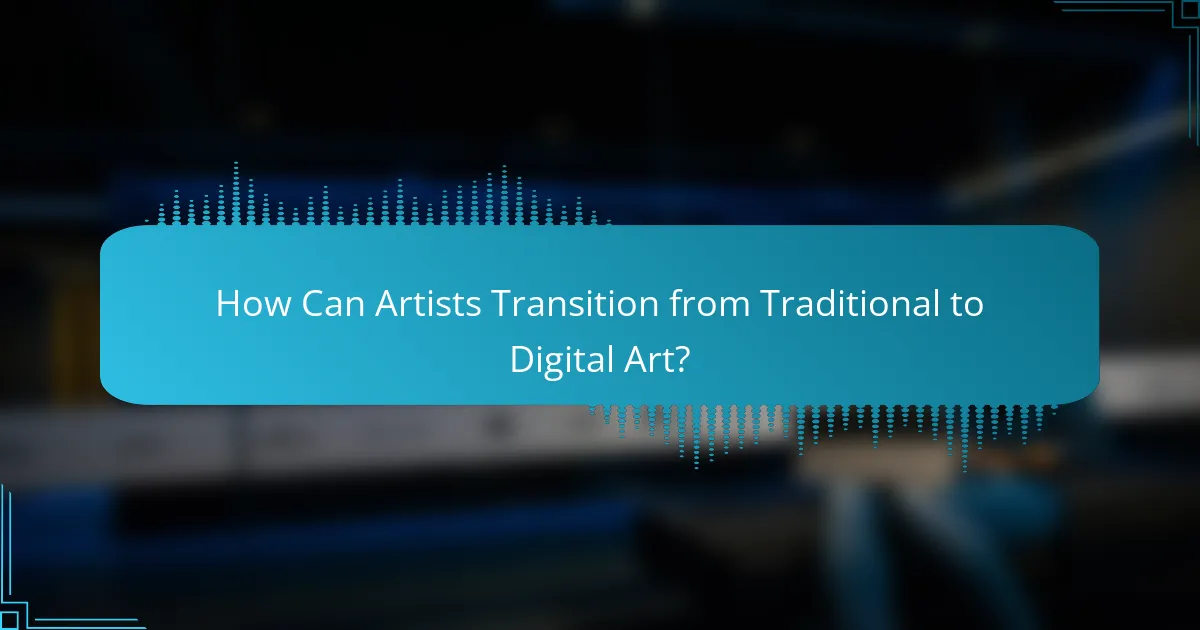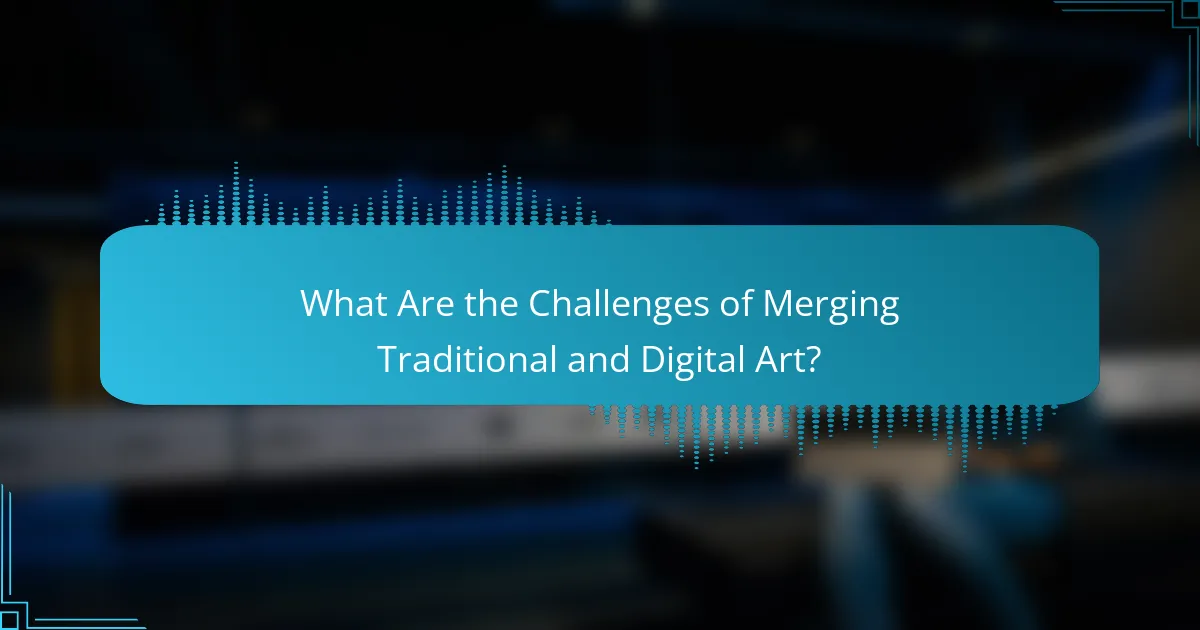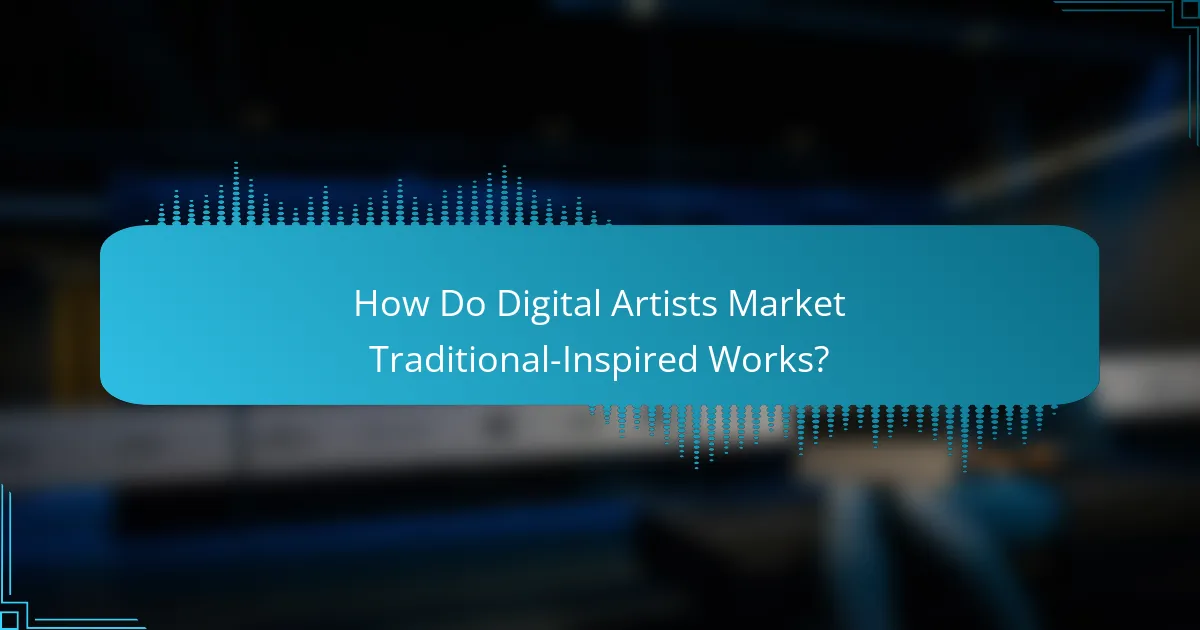Digital art is profoundly influenced by traditional art styles, which provide essential techniques and aesthetic foundations. By drawing inspiration from historical movements, artists blend classic methods with modern technology, creating unique pieces that resonate with both contemporary and historical aesthetics.

How Do Traditional Art Styles Influence Digital Art?
Traditional art styles significantly shape digital art by providing foundational techniques and aesthetic principles. Artists often draw inspiration from these historical movements to enhance their digital creations, blending classic methods with modern technology.
Impressionism in Digital Painting
Impressionism influences digital painting through its emphasis on light, color, and brushstroke techniques. Digital artists can replicate the soft, blended colors and dynamic compositions characteristic of Impressionist works using various brushes and layering techniques in software like Adobe Photoshop or Procreate.
To effectively incorporate Impressionism, focus on using a limited color palette and experiment with brush settings to create texture. Quick, loose strokes can help capture the essence of a scene rather than its precise details, allowing for a more emotive representation.
Surrealism in Digital Collage
Surrealism’s dreamlike qualities and unexpected juxtapositions are easily translated into digital collage. Artists can combine various elements from photographs, textures, and illustrations to create fantastical scenes that challenge reality.
When creating a surreal digital collage, consider using layers and blending modes to merge images seamlessly. Incorporate unusual combinations of objects and settings to evoke a sense of wonder or intrigue, while maintaining a cohesive color scheme to unify the piece.
Realism Techniques in Digital Illustration
Realism techniques in digital illustration focus on accurate representation and detail. Artists can utilize high-resolution images and advanced rendering techniques to achieve lifelike results, mimicking traditional methods like oil painting or graphite drawing.
To enhance realism, pay attention to lighting, shadows, and textures. Use reference images to study proportions and anatomy, and consider employing tools like 3D models to understand complex forms better. Regular practice and critique can significantly improve your realistic digital illustrations.

What Are Popular Digital Art Styles Inspired by Traditional Art?
Popular digital art styles influenced by traditional art include techniques that mimic classic mediums while leveraging digital tools. Artists often blend these styles to create unique pieces that resonate with both contemporary and historical aesthetics.
Digital Watercolor Techniques
Digital watercolor techniques replicate the fluidity and transparency of traditional watercolor painting. Artists use software that simulates brush strokes and color blending, allowing for vibrant washes and subtle gradients.
When creating digital watercolors, consider using layers to build depth and texture. Tools like Adobe Photoshop or Procreate offer brushes specifically designed for watercolor effects, enabling artists to achieve realistic results without the mess of physical paint.
Vector Art Inspired by Cubism
Vector art inspired by Cubism focuses on geometric shapes and fragmented forms, reminiscent of the early 20th-century art movement. This style utilizes software like Adobe Illustrator to create scalable images that maintain clarity at any size.
To effectively create Cubist vector art, start by breaking down subjects into basic shapes and experimenting with perspective. Use a limited color palette to emphasize the geometric nature of the artwork, and consider layering shapes to add complexity and depth.

How Can Artists Transition from Traditional to Digital Art?
Artists can transition from traditional to digital art by familiarizing themselves with digital tools and techniques while leveraging their existing skills. This shift involves understanding software options, adapting traditional methods, and practicing consistently to build confidence in a new medium.
Essential Software for Digital Art
Choosing the right software is crucial for digital artists. Popular options include Adobe Photoshop, Corel Painter, and Procreate, each offering unique features tailored to different artistic styles. For beginners, programs like Krita and GIMP provide free alternatives with robust capabilities.
When selecting software, consider factors such as compatibility with your hardware, user interface, and the specific tools you need for your art style. Subscription models versus one-time purchases can also influence your decision, so evaluate your budget accordingly.
Techniques for Adapting Traditional Skills
To effectively adapt traditional skills to digital art, start by replicating familiar techniques using digital tools. For instance, if you are skilled in watercolor painting, explore digital brushes that mimic watercolor effects. This approach helps bridge the gap between mediums while maintaining your artistic voice.
Practice layering, blending, and texture creation in digital formats, as these techniques are often similar to traditional methods. Additionally, take advantage of digital features like undo options and customizable brushes, which can enhance your creative process and reduce frustration.

What Tools Enhance Traditional Art Techniques in Digital Formats?
Digital tools like Adobe Photoshop and Procreate effectively replicate traditional art techniques, allowing artists to create stunning works with enhanced flexibility and efficiency. These applications provide a range of brushes, textures, and features that mimic traditional mediums while offering unique digital advantages.
Adobe Photoshop for Digital Painting
Adobe Photoshop is a powerful tool for digital painting, known for its extensive brush library and customizable settings. Artists can simulate oil, watercolor, and acrylic paints, making it ideal for those transitioning from traditional to digital mediums.
When using Photoshop, consider utilizing layers to separate different elements of your artwork. This allows for easier adjustments and corrections without affecting the entire piece. Additionally, experimenting with blending modes can create unique effects that enhance depth and texture.
Procreate for Digital Sketching
Procreate is a popular choice for digital sketching, especially among illustrators and concept artists. Its intuitive interface and responsive touch controls make it easy to create quick sketches or detailed illustrations on the go, particularly on iPads.
One key feature of Procreate is its ability to record your drawing process, allowing you to review or share your techniques. For effective sketching, take advantage of the QuickShape tool to create perfect shapes and the symmetry feature for balanced designs. This can save time and improve the overall quality of your sketches.

What Are the Challenges of Merging Traditional and Digital Art?
Merging traditional and digital art presents challenges such as maintaining authenticity and navigating technical limitations. Artists must balance their unique styles with the capabilities and constraints of digital platforms.
Maintaining Authenticity
Authenticity is a key concern when blending traditional and digital art. Artists often worry that digital tools may dilute the personal touch and emotional depth found in traditional methods. To preserve authenticity, artists can incorporate hand-drawn elements into their digital works or use digital tools that mimic traditional techniques.
For instance, using a stylus on a tablet can replicate the feel of painting with a brush, allowing for a more genuine artistic expression. Additionally, artists should consider sharing their traditional works alongside digital pieces to showcase their full range of skills and maintain a connection to their roots.
Technical Limitations of Digital Platforms
Digital platforms come with inherent technical limitations that can affect the final artwork. Factors such as resolution, color accuracy, and software capabilities can constrain an artist’s vision. For example, low-resolution images may not capture the detail of a traditional painting, leading to a loss of quality.
To mitigate these issues, artists should familiarize themselves with the specifications of their chosen digital tools. Using high-resolution settings and understanding color profiles can enhance the quality of digital art. Additionally, artists should regularly update their software to access the latest features and improvements, ensuring their work remains competitive and visually appealing.

How Do Digital Artists Market Traditional-Inspired Works?
Digital artists can effectively market traditional-inspired works by leveraging online platforms and showcasing their unique styles. By utilizing social media and creating online portfolios, artists can reach wider audiences and attract potential buyers.
Utilizing Social Media Platforms
Social media platforms like Instagram, Facebook, and Pinterest are essential for digital artists to showcase their traditional-inspired works. These platforms allow artists to share images, engage with followers, and participate in art communities, which can significantly increase visibility.
To maximize impact, artists should post consistently and use relevant hashtags to reach their target audience. Engaging with followers through comments and direct messages can also foster a loyal community and encourage word-of-mouth promotion.
Creating Online Portfolios
An online portfolio is crucial for digital artists to present their traditional-inspired works in a professional manner. Websites like Behance, ArtStation, or personal domains allow artists to curate their best pieces and provide context about their artistic influences.
When creating a portfolio, artists should focus on high-quality images and detailed descriptions that highlight the traditional techniques used in their digital art. Including a blog or a section on the creative process can further engage visitors and enhance the artist’s narrative.


